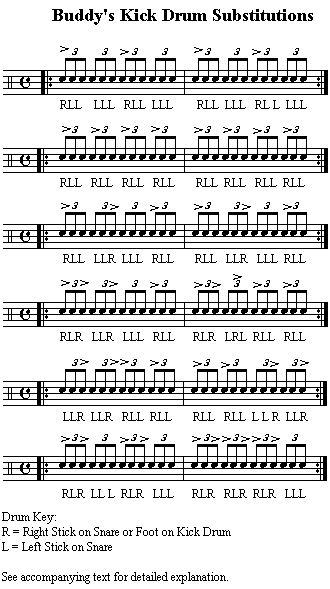Pro Drummer Secrets: Buddy's Bag
Part One
Buddy's Kick Drum Substitutions
Video Lesson Supplement
BA-di-di di-di-BA di-di-di BA-DI-DI / BOOM-di-di di-di-BOOM DI-DI-DI BOOM-DI-DI Some loved him and some hated him, but no one could say that Buddy Rich's playing lacked excitement. Although I met him a number of times, I regret that I never had the opportunity to sit down and workout with him. However, I studied everything he did. And one of his favorite drumming techniques (judging from how often he used it) was the Kick Drum Substitution. If you've ever seen or listened to Buddy play, I'm sure you've heard it too. He was a true master of this technique, which is performed by duplicating your accented right hand sticking on your Kick Drum. Buddy used the technique for his extended drum solos as well short fills.
Although other drummers have copied his substitution technique, no one has been able to "burn it up" quite like Buddy.
This week, I'll show you how to develop Buddy's Kick Drum Substitution. Who knows? Maybe someday you'll be the one who does it better than Buddy.
Build It Around Triplets
We begin our study using triplet patterns because that's what Buddy preferred to play. For those of you
unfamiliar with triplets, a triplet is a group of 3 notes marked with a 3 above or below the notes. When
played, the three notes take the same time value as 2 notes in the triplet usually get. If you take a look at
the exercises I've written out below, you'll see that they all consist of eighth-note triplets.
The simplest way to count these triplets is as follows: 1-trip-let 2-trip-let 3-trip-let 4-trip-let. (If you'd like to learn more about reading music in general, refer to Tiger Reading 101 through 103 in the "Related Links" sidebar.)
To start these exercises, you'll need a drum set that has at least a Kick Drum and a Snare. Study the first 2-bar exercise below. The first time you play it, play all R parts on the Snare Drum with your right stick and make sure you accent each one (>) as written. Play all of the L parts with your left stick on the Snare Drum (unaccented). Once you reach the repeat sign at the end of the second measure, go back to the first measure and play the exercise over again. This time, play all the R parts with your foot on the Kick Drum instead of your right stick on the Snare. The L parts are still played with your left stick on the Snare. This allows you to practice duplicating the right stick accents on your Kick Drum, just the way Buddy did. Practice each of the six 2-bar phrases separately until each exercise becomes comfortable and easy to play.
Once you've perfected each of the six 2-bar exercises separately, practice them all the way through. Repeat each 2-bar phrase once before moving on to the next without stopping.

At first, you may have trouble keeping the triplets sounding even, especially between the Kick Drum and your
left stick Snare part. But with practice, the exercises will become second nature. Although you should
eventually work them up to a speed of at least quarter-note = 160 on the metronome, start at quarter-note =
60. Once you can play these exercises correctly at slow speed, you can gradually increase your speed. The
trick is to develop an even sound between the right stick Snare part and the Kick Drum. Just as though the
Kick Drum was another hand.
I think you've got enough to play with for this week. Next week, I'll bring you more from Buddy's Bag of tricks. By the way, the drumwords in the opening of this article is a verbal representation of which of the six exercises? Let me know .
Until next time: Stay loose.
Click the following link for Part 2 of Pro Drummer Secrets: Buddy's Bag!
